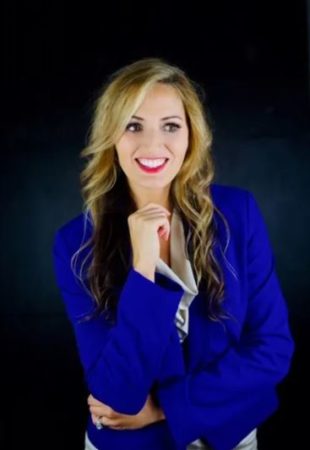Jenna’s Law is named after Jenna Quinn, a child sexual abuse survivor, author, and TED speaker.
 Jenna Quinn is a pioneer in the national child sexual abuse prevention movement. Jenna first introduced the legislation in Texas, where it was unanimously passed in 2009. Since then, Quinn has helped implement child sexual abuse and sex trafficking prevention education mandates in over 26 states. In 2019, the Jenna Quinn Law was filed federally by Texas state senator John Cornyn.
Jenna Quinn is a pioneer in the national child sexual abuse prevention movement. Jenna first introduced the legislation in Texas, where it was unanimously passed in 2009. Since then, Quinn has helped implement child sexual abuse and sex trafficking prevention education mandates in over 26 states. In 2019, the Jenna Quinn Law was filed federally by Texas state senator John Cornyn.
Jenna’s Law Requirements:
According to JennaQuinn.net, Jenna’s Law requires that all public schools in each state mandate K-12 sexual abuse prevention for:
- Students
- School staff
- Caregivers
Since its first passing in 2009, Jenna’s Law was amended and expanded to include other forms of abuse and require other child-serving agencies to be educated in sexual abuse prevention. It also now includes sex trafficking prevention for students and teachers in schools.
If you’re a school administrator, school counselor, social worker, parent, or other concerned citizen looking to implement programs to meet Jenna’s Law, Darkness to Light has partnered with the Monique Burr Foundation for Children to bring you Prevent 360° which offers evidence-based curriculum for children and youth and evidence-informed curriculum for educators, parents, and caregivers.
Jenna’s Law for Teachers & Jenna’s Law for School Counselor:
School personnel identifies 52% of all identified child abuse cases classified as causing harm to the child, more than any other profession, including child protective services and the police.1 Frequently, school districts that implement Jenna’s Law are only passing the first part of the law and requiring students only to be trained. The above statistic shows the importance of educators and adults being educated in child sexual abuse prevention and recognition. When a teacher is a safe adult, they must be prepared to hear a child’s disclosure and know how to respond in an appropriate manner. Darkness to Light’s Stewards of Chlidren® evidence-informed training teaches adults to prevent, recognize, and react responsibly to child sexual abuse.
Results of several evaluations of educators post-training clearly demonstrate the importance of training adults in Stewards of Children®:
-
- 90% of teachers taking Stewards of Children® training report that they are more willing to report suspicions of abuse after completing the program.2
- 93% of teachers completing Stewards of Children® training said they would be more likely to recognize signs of abuse.2
- 88% of teachers report that they are more likely to talk to a child about child sexual abuse after completing Stewards of Children® training.2
- 91% of teachers taking Stewards of Children® training would recommend it to colleagues.2
Prevent 360° pairs child- and adult-focused curriculum so you can successfully comply with Jenna’s Law.
Jenna’s Law for Parents & Caregivers:
Knowing that one in 10 children will be sexually abused before their 18th birthday and that 90% of children who are victims of sexual abuse know their abuser, it’s vital that parents and caregivers are educated in child sexual abuse prevention.3,4,5 It can be uncomfortable to talk to your kids about sex and sexual abuse, but it doesn’t have to be. It’s important to have open, honest, and age-appropriate conversations with kids about sex, boundaries, healthy relationships. By being a safe adult, a child can trust you to be there for them when they need help. Darkness to Light’s Stewards of Children® teaches parents and caregivers to prevent, recognize, and react responsibly to child sexual abuse.
To learn more about Jenna’s Story, click here.
Jenna's Law Requirements by State
There is currently no child sexual abuse prevention education mandate, however, Senate Bill 77 is pending.
Senate Bill 4070B requires child sexual abuse prevention education for K-8 public-school students. There is no requirement for personnel. To learn more, click here.
Senate Bill 856 requires child sexual abuse prevention education for all public-school personnel and K-12 students. To learn more, click here.
House Bill 1041 requires child sexual abuse education for licensed child–care facility staff, public-school personnel, and K-12 students. To learn more, click here.
References:
-
Sedlak, Andrea, et al. Fourth National Incidence Study of Child Abuse and Neglect (NIS–4). U.S. Department of Health and Human Services, Administration for Children and Families, 2010, p. 16, acf.hhs.gov/sites/default/files/documents/opre/nis4_report_congress_full_pdf_jan2010.pdf.
-
Townsend, C., Haviland, M. (2016). The impact of child sexual abuse training for educators on reporting and victim outcomes: The Texas Initiative. Charleston, S.C., Darkness to Light. Retrieved from https://www.d2l.org/site/c.4dICIJOkGcISE/b.9358399/k.5FEC/Efficacy_of_Stewards.htm.
-
Rheingold, Alyssa, & Catherine Townsend. Estimating a Child Sexual Abuse Prevalence Rate for Practitioners: Studies. Darkness to Light, 2013, d2l.org/wp-content/uploads/2017/02/prevalence-rate-white-paper-D2L.pdf.
-
Finkelhor, David, & Richard Ormrod. “Characteristics of Crimes Against Juveniles.” Juvenile Justice Bulletin, 2000, p. 7, scholars.unh.edu/cgi/viewcontent.cgi?article=1002&context=ccrc.
-
Whealin, Julia. “Child Sexual Abuse.” U.S. Department of Veterans Affairs, 2007, www.ptsd.va.gov/professional/treat/type/sexual_abuse_child.asp.



